Research Update
Today a drilling team came out and drilled diving holes in the sea ice so Terry and the dive team could collect sediment samples from the seafloor. In the afternoon, a shelter was put over one of the dive holes and Terry and the dive team collected samples.
Mail for Me!
This morning I made it to the Post Office before meeting up with my research team. I knew I had a package waiting because I saw my name on a posted list. When I went to the mailroom, I was surprised to see I had two packages waiting for me!
 Michelle Brown picks up her packages at the USAP Post Office.
Michelle Brown picks up her packages at the USAP Post Office.
Drilling Holes in the Sea Ice
Since we already marked the locations of our dive holes the other day, the driller could easily find where to drill diving holes. Mel Sannes and Frank Aldridge arrived in a Challenger Caterpillar that was rigged with a snow blade. The impressive machine also pulled a Reed drill, which can drill holes in the sea ice large enough for divers to fit through.
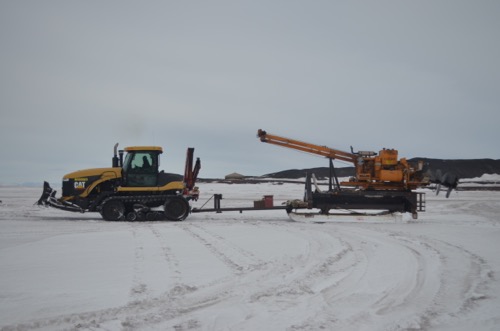 Mel operates the Challenger Caterpillar and Reed drill to make holes in the sea ice.
Mel operates the Challenger Caterpillar and Reed drill to make holes in the sea ice.
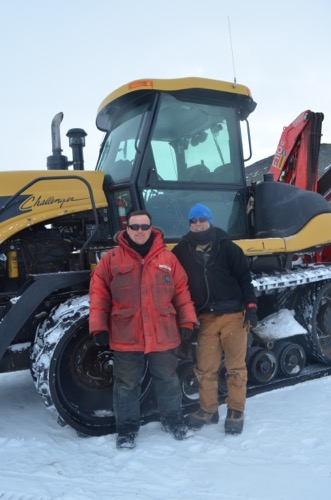 Frank Aldridge, left, and Mel Sannes, right, are the people who make it possible for divers to get through the ice.
Frank Aldridge, left, and Mel Sannes, right, are the people who make it possible for divers to get through the ice.
While Mel and Frank drilled holes in the ice, Terry and Steve helped shovel out the snow and ice that was pulled up. Andrew, Carl and I then cleared the holes of sea ice with nets and marked the holes with black flags, indicating caution.
 Our team clears out the snow and ice from the hole as Mel drills.
Our team clears out the snow and ice from the hole as Mel drills.
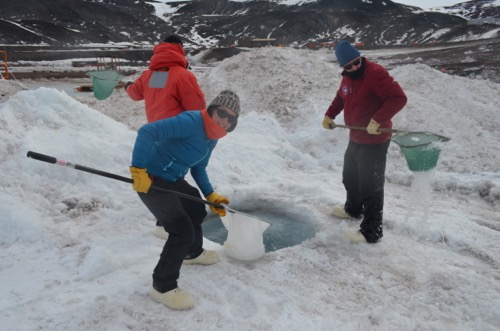 Michelle Brown helps Andrew Klein and Carl Green clear ice from the freshly drilled dive hole.
Michelle Brown helps Andrew Klein and Carl Green clear ice from the freshly drilled dive hole.
Collecting Samples Under the Ice
By the afternoon, all of our holes had been drilled. A "tomato" shelter was then dragged over a diving hole at the intake valve sampling site. The intake valve is where sea water is pumped into the water processing plant to be processed and used for water in the station. It is fairly clean water and the sediment there is not as polluted as other areas of McMurdo Sound. We expect the sediment samples here will be fairly clean.
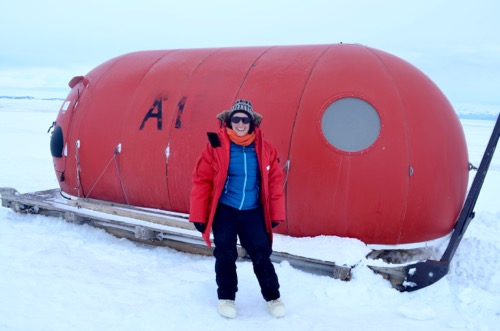 Michelle Brown stands outside the tomato shelter where our team stays warm as we wait for sediment samples from the seafloor.
Michelle Brown stands outside the tomato shelter where our team stays warm as we wait for sediment samples from the seafloor.
Our benthic ecologist, Terry, dove under the sea ice along with United States Antarctica Program (USAP) divers, Brenda Konar and Steve Rupp.
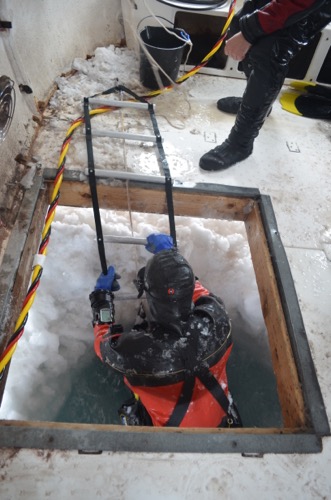 Terry Palmer climbs out of a dive hole after collecting sediment samples 120 feet below.
Terry Palmer climbs out of a dive hole after collecting sediment samples 120 feet below.
The divers collected sediment samples from the sea floor, which was about 120 feet below the surface. They also collected benthic organisms (those found on the seafloor) which our research team will sample for pollutants in their tissues.
 Michelle Brown holds a large sea star which was collected for tissue sampling from the sea floor.
Michelle Brown holds a large sea star which was collected for tissue sampling from the sea floor.
 A few polychaete worms from the seafloor are collected to sample for pollutants.
A few polychaete worms from the seafloor are collected to sample for pollutants.
 Steve Sweet examines a sediment sample from the sea floor.
Steve Sweet examines a sediment sample from the sea floor.
Critical Thinking
How did pollutants get inside the tissues of the sea star or polychaete worms? Answer the question in the "Ask the Team" section!
Bob's Puzzler
Meals at McMurdo Station are always enjoyable, especially because we often get to talk to interesting, science-minded people. I had the opportunity to dine with an old friend, Bob Melville. Bob is an engineer from New Jersey Institute of Technology whom I worked with in 2011 and who always has a great riddle to share during a meal.
 Meet Bob Melville, an adept engineer and entertaining friend.
Meet Bob Melville, an adept engineer and entertaining friend.
Here is a riddle Bob shared with me:
Measuring Coins
There are ten bags of coins. Each bag has ten coins in them and weighs exactly 10.00 grams, except one bag which is ever so slightly heavier and weighs 10.03 grams. How can you determine which bag is slightly heavier if you can only measure the bags on a precise, electric scale once? You can do most things to the bags of coins, as long as you only take one reading on the scale.
The answer is not a trick or surprise, but an elegant solution that requires careful thought. Share your answer on the "Ask the Team" page. The first right response will earn a postcard from Antarctica!
Ice Picture of the Day
Today's Ice POD is about the sea stars in Antarctica. You can download a PowerPoint slide here: 12_icepod.pptx
 This Ice POD discusses sea stars.
This Ice POD discusses sea stars.
Brought to you by...
Today's journal is brought to you by a student from Ms. Martinez's class from Eagle Pass ISD. The penguin hung around the dive hole today and has a great motto: "Be yourself, because an original is more than a copy."
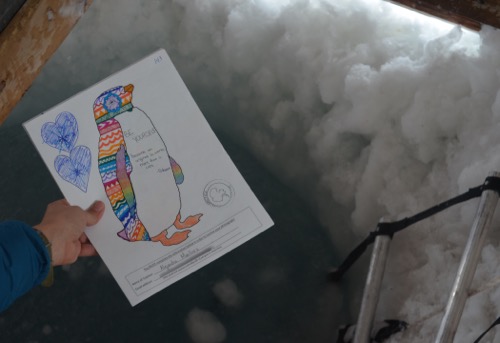 Today's journal was brought to you by Ms. Martinez's student from Eagle Pass ISD.
Today's journal was brought to you by Ms. Martinez's student from Eagle Pass ISD.
Comments